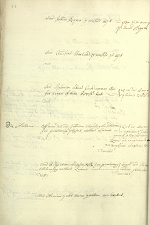Becoming a Midwife
The best sources we have for understanding how a woman became a midwife come from the Church of England’s Archives. If a woman wished to be licensed as a midwife, she had to provide Church officials with testimonials attesting to her skill in the delivery room, her religious reliability (no Catholics or Quakers need apply!), and her moral standing within the community. (For more on the licensing process, see Midwives and the Church.)
 In addition, church officials periodically visited individual parishes to ensure (among other things) that medical practitioners, school teachers, and parish clerks had obtained the requisite licenses. The names of officials who did not have licenses were then noted by church officials. (For the records of one such visitation, click on the image to the right.) While the nominations and visitations cannot offer a definitive picture of the route women took into midwifery, they do offer some clues.
In addition, church officials periodically visited individual parishes to ensure (among other things) that medical practitioners, school teachers, and parish clerks had obtained the requisite licenses. The names of officials who did not have licenses were then noted by church officials. (For the records of one such visitation, click on the image to the right.) While the nominations and visitations cannot offer a definitive picture of the route women took into midwifery, they do offer some clues.
The first trend that we see in these records is that midwives often followed their mothers or mothers-in-law into the practice, and even worked together. In 1674, two Nottinghamshire midwives, Elizabeth and Mary Golstropp, were cited for failing to appear at the visitation, as were Margaret and Elizabeth Kilton of Leak, Yorkshire in 1682. While we cannot know if these were mother/daughter or mother/daughter-in-law teams, there is no such question for Elizabeth Green of Whitby. According to her nomination, “Elizabeth Green is a person of good report, did accompany her mother Anne Yeoman aforesaid, when called by women in travail [labor] to doe the office of a midwife as her mother Anne Yeoman’s assistant.”
In addition to mothers training their daughters, we have evidence of women and their servatns working together. This is true of Bridget Hodgson who trained her servant Martha Stopford in midwifery (both in fact and fiction), as we know that Margaret Coakes worked with her servant Julia Raper, though it is not clear who trained whom. (It seems likely that the Margaret trained Julia, but not out of the question it was the other way around.) It also appears that midwives would sometimes train their own successors, as in the case of Dorothy Smith, who lived in the suburbs of York. According to her nomination, the previous midwife "in her life time resigning her office to her [Dorothy]."
Once woman became a midwife, her status within the local community changed in ways that historians are only now beginning to understand. Midwives were privy to "the secrets of women," and with that knowledge came power. But their power also stemmed from their relationship to the Church and to the early modern legal system. To explore these aspects of midwifery, click on one of the links below.